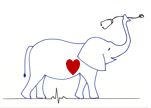Shock Quiz
1.Which of the following clinical signs is not typical for a classic presentation of shock?
a. Cool extremities
b. Weak pulses
c. Systemic hypertension
d. Tachypnea
Answer
2. In shock, which of the following statements is true relative to oxygen consumption (VO2)
a. Oxygen demand exceeds oxygen delivery
b. Oxygen delivery and oxygen demand are determined by stroke volume
c. Because DO2 is greater than VO2 in shock situations, anaerobic metabolism results in formation of lactate
d. As long as VO2 is greater than DO2, anaerobic metabolism will be minimal and blood lactate levels will remain normal
Answer
3. A 13-year-old SF Maltese presents to your clinic after the owner found her collapsed. She appears to be having difficulty breathing and membranes are cyanotic. Upon auscultation you hear pulmonary crackles and a loud systolic heart murmur. Thoracic radiographic findings include left atrial enlargement and perihilar pulmonary edema. She is hypotensive, with an elevated blood lactate, and the overall clinical picture is typical for cardiogenic shock. Which of these therapies would usually be contraindicated in this case?
a. Intravenous crystalloid fluids
b. Intravenous furosemide
c. Oxygen administration
d. Pimobendan
Answer
4.Which of the following is not a major mechanism for lack of oxygen delivery to tissues?
a. Inadequate blood volume
b. Inadequate cardiac performance
c. Inadequate vascular tone
d. Increased coronary perfusion
Answer
5.Which of the following clinical findings is often a result of activation of the sympathetic nervous system?
a. Decreased inotropy
b. Increased heart rate
c. Decreased arterial tone
d. Increased liver enzymes
Answer
6.Which of the following is most accurate relative to blood volume and fluid therapy in dogs and cats?
a. The normal blood volume of a cat is 90 mL/kg
b. The normal blood volume of a dog is 60mL/kg
c. A full shock dose of fluids for a 5 kg cat would be approximately 250 to 300 mL
d. A full shock dose of fluids for a 35 kg dog would be approximately 1.8 to 2.2 L
Answer
7. A dog presents with tachycardia, tachypnea, hypotension, elevated blood lactate, hypoglycemia, neutropenia, and hypothermia. On thoracic radiographs the VHS is 8.3 and the pulmonary arteries and veins are small. Which of the following forms of shock is most likely, and what treatment is reasonable for this situation?
a. Septic shock; administer crystalloid fluids and broad-spectrum antibiotics
b. Hemorrhagic shock; administer fresh frozen plasma and norepinephrine
c. Hypovolemic shock; administer crystalloid fluids and high dose corticosteroids
d. Cardiogenic shock; administer crystalloid fluids and norepinephrine
Answer
8. Your colleague asks you to calculate a full shock dose of crystalloid fluids on the emergency patient that just came in. The dog in question is a Labrador retriever that weights 30 kg. Which of the following fluid volumes would be in the correct range for a complete shock dose of crystalloid fluids in this case?
a. 300 mL
b. 800 mL
c. 2500 mL
d. 5000 mL
Answer
9. Which of the following is an advantage of intravenous crystalloid balanced electrolyte solutions (e.g., a replacement type of fluid)?
a. Fewer adverse reactions than blood products in most shock situations
b. Cost is approximately equal to whole blood
c. More than 75% of administered crystalloid fluids persist in the intravascular space at 4 hours post-administration
d. Crystalloid fluids typically contain an acidifying agent to help move potassium back into cells
Answer
10. In which instance would you be most likely to administer a vasopressor or inotropic drug to an animal in shock?
a. When hypotension persists despite restoration of normal blood volume, and thus vascular tone or cardiac function is suspected to be the problem
b. Vasopressors are usually the first choice to fix deficits in blood volume
c. Usually inotropes would be started when hypotenstion persists after 24-48 hours of administering maintenance fluid volumes
d. Usually inotropes and vasopressors are only administered AFTER shock is resolves, as earlier administration might lead to cardiac arrhythmias or systemic hypertension
Answer
